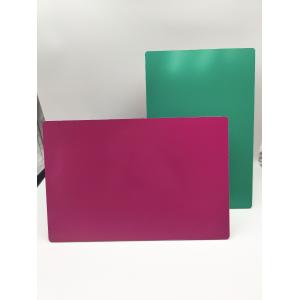

Add to Cart
Brushed Finish PVDF ACP Sheet - 4.0mm - Ideal for Interior Design
Understood as aluminum composite panels, aluminum plastic panels represent a multi-layer composite material made of two pre-painted aluminum sheets bonded to a non-aluminum core. This material stands out for its mechanical strength, light weight, and remarkable resistance to environmental conditions, making it a favorite for outdoor and indoor building cladding. It's also widely used in signage due to its printable surface and ease of handling. The availability of different core materials provides options for fire-resistance and other specific requirements.
Product processing performance
Using typical woodworking and metalworking tools, the aluminium composite panels manufactured by our company can be effectively processed and molded. Operations such as cutting, sawing, milling, punching, pressing, folding, and bending can be undertaken with ease. This makes it possible to create various forms with precision that are needed in architectural decoration design, specifically for shapes like arcs, counter-arcs, small-radius corners, and internal and external corners. Such a high level of adaptability is unprecedented in other decoration materials.
1. Cutting: Cutting tool, electric saw, hand saw, ring saw, etc.
2. Slot Milling: After processing with an electric and portable
slot milling machine, the product can be manually bent into various
kinds of polyhedrons.
3. Corner Removing: After processing with a puncher and corner
removing machine, it can be combined in a trunk.
4. Welding: The product can be welded with plastic welding rods and
hot wind welders.
5. Corner Bending: After processing with a slot milling machine,
the product can be bent into various corners.
6. Bending: The product can be bent using 3-point or 3-rolling
machines.
7. Printing: The product can be printed with screen printing
plates.
8. Assembling: Rivet, nail, self-tapping screw, etc.
9. Punching: The product can be punched with an open puncher.
Product Features
1. Lightweight: Has a very high strength-to-weight ratio. With the
same stiffness (E.j), the weight per unit area of aluminum
composite panels is about only 60% of that of aluminum plates and
30% of steel plates.
2. Strong Adhesion: Has high 180° peeling strength. After long-term
use, the aluminum plate and the plastic core material will not
automatically peel off.
3. Weather Resistance: When used outdoors for a long time, there is
virtually no change in color and gloss, the coating does not fall
off, and the general lifespan is over twenty years.
4. Corrosion Resistance: The surface coating has strong adhesion
and can resist the corrosion of acid (10%H2S04), alkali (10%NaOH),
and salt mist; the PVDF fluorocarbon resin coating is especially
strong.
5. Wind Pressure Resistance: The performance reaches the national A
level, meeting the requirements of wind pressure resistance for
high-rise exterior wall decoration.
6. Flame Resistance: The core layer is non-toxic polyethylene, and
its two sides are non-combustible aluminum thin plates.
Our Company
Established in 1999, we have leveraged advanced continuous extrusion hot composite sheet production equipment for the manufacturing of premium Aluminum Composite Panels. Our products, offering remarkable features like fade and corrosion resistance, flame and moisture resistance, have revolutionized the modern decoration trends. We pride ourselves on being the first to pass the ISO 9001:2008 certification and have been acknowledged with various honors. Our "Richly Bound" brand signifies diverse, high-quality product offerings.
Application fields
1.Architectural Facades: Applied as an exterior facing for
skyscrapers, residential houses, corporate workspaces, and business
towers.
2.Interior Design: Incorporated into the internal aesthetics of
residences, workspaces, and commercial locales, including wall
installations, ceiling concepts, and dividing panels.
3.Signposting: Employed for outdoor advertising, storefront
displays, directional markers, digitally printed signs, and
exhibition stages.
4.Transit Sector: Utilized in the construction of vehicle
components for buses, trains, metro systems, aircraft, and
seafaring vessels.
5.Home Furnishing: Used in the fashioning of furniture, cupboards,
kitchen counter surfaces, and other domestic fixtures.
6.Industrial Applications: Implemented in factories as shell
materials for machinery, shielding for tools, and sterile room
uses.
7.Shopfront Designs: Applied in the creation of retail outlets,
booth structures, and indoor display modules.
Product installation process diagram
